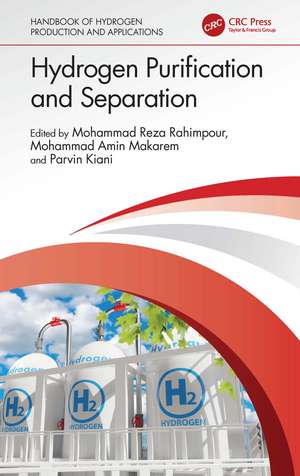Hydrogen Purification and Separation
Editat de Mohammad Reza Rahimpour, Mohammad Amin Makarem, Parvin Kianien Limba Engleză Hardback – 6 noi 2024
- Introduces miscellaneous membrane‑assisted processes for hydrogen separation
- Provides different physiochemical absorption methods for hydrogen purification
- Discusses application of sorbents and swing technologies in hydrogen purification
- Uniquely covers hydrogen separation using novel methods
- Includes economic assessments and environmental challenges of hydrogen purification in detail
Preț: 1008.35 lei
Preț vechi: 1229.69 lei
-18% Nou
Puncte Express: 1513
Preț estimativ în valută:
192.97€ • 199.35$ • 160.60£
192.97€ • 199.35$ • 160.60£
Carte tipărită la comandă
Livrare economică 26 martie-09 aprilie
Preluare comenzi: 021 569.72.76
Specificații
ISBN-13: 9781032466057
ISBN-10: 1032466057
Pagini: 365
Ilustrații: 122
Dimensiuni: 156 x 234 mm
Greutate: 0.69 kg
Ediția:1
Editura: CRC Press
Colecția CRC Press
Locul publicării:Boca Raton, United States
ISBN-10: 1032466057
Pagini: 365
Ilustrații: 122
Dimensiuni: 156 x 234 mm
Greutate: 0.69 kg
Ediția:1
Editura: CRC Press
Colecția CRC Press
Locul publicării:Boca Raton, United States
Public țintă
PostgraduateCuprins
Section I: An Overview of Hydrogen Purification and Separation Methods. 1. Introduction to Hydrogen Separation and Purification Technologies. 2. Economic Assessments and Environmental Challenges of Hydrogen Separation and Purification Technologies. Section II: Hydrogen Separation Using Membranes. 3. Polymeric Membranes for Hydrogen Separation. 4. Zeolite Membranes for Hydrogen Separation. 5. Hydrogen Separation Using Ceramic Membranes. 6. Hybrid Membranes for Hydrogen Separation. 7. Silica Membrane for Hydrogen Separation. 8. Mixed Matrix Membranes for Hydrogen Separation. 9. Hollow Fiber Membrane for Hydrogen Separation. 10. Porous Inorganic Membranes for Hydrogen Separation. Section III: Absorption and Absorption Methods for Hydrogen Purification. 11. Hydrogen Purification by Ionic Liquids and Deep Eutectic Solvents. 12. Carbonaceous Sorbents for Hydrogen Purification. 13. Metal–Organic Frameworks for Hydrogen Purification. 14. Swing Technologies for Hydrogen Purification. Section IV: Other Technologies for Hydrogen Purification. 15. Plasma‑Assisted Technology for Hydrogen Purification.
Notă biografică
Mohammad Reza Rahimpour is a Distinguished Professor of Chemical Engineering at Shiraz University, Iran. He earned a PhD in chemical engineering at Shiraz University, in collaboration with the University of Sydney, Australia, in 1988. He leads a pioneering research group specializing in fuel processing technology, with a particular focus on the catalytic conversion of both fossil fuels, such as natural gas, and renewable fuels, like bio‑oils derived from lignin, into valuable energy sources. Throughout his academic career, Dr. Rahimpour has specialized in hydrogen production technologies, including steam methane reforming, water electrolysis, photocatalytic hydrogen production, and hydrogen production from both renewable sources and fossil fuels. His extensive expertise and innovative research significantly contribute to advancements in hydrogen production and its practical applications.
Mohammad Amin Makarem earned a PhD in chemical engineering at Shiraz University. His research interests include gas separation and purification, nanofluids, microfluidics, catalyst synthesis, reactor design, and green energy.
Parvin Kiani earned a degree in chemical engineering at Shiraz University. Her research has focused on gas separation, clean energy, and catalyst synthesis.
Mohammad Amin Makarem earned a PhD in chemical engineering at Shiraz University. His research interests include gas separation and purification, nanofluids, microfluidics, catalyst synthesis, reactor design, and green energy.
Parvin Kiani earned a degree in chemical engineering at Shiraz University. Her research has focused on gas separation, clean energy, and catalyst synthesis.
Descriere
This book reviews hydrogen separation methods as well as membranes used in hydrogen separation. It discusses absorption and adsorption methods as well as novel technologies like cryogenic methods and plasma-assisted technology and discusses related economic assessments and environmental challenges.
